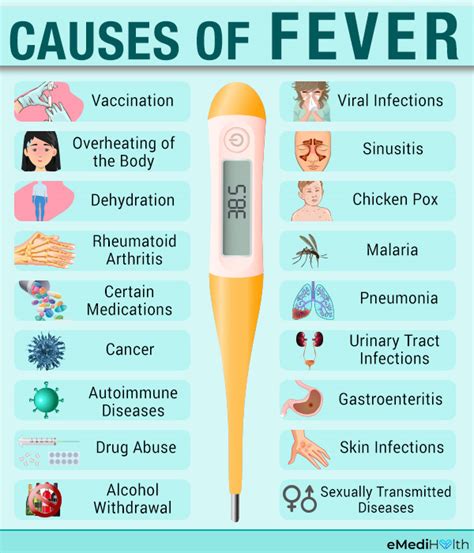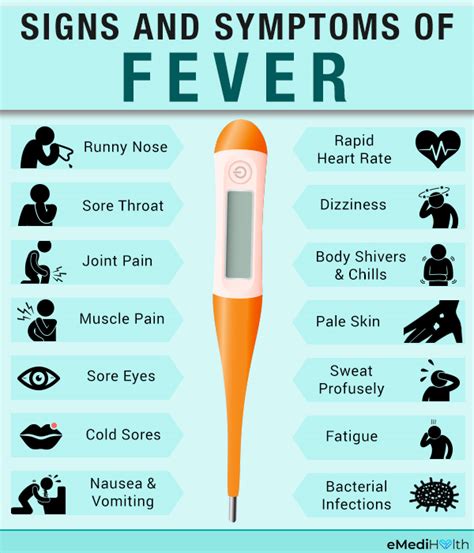Intro
Learn about fever causes, symptoms, and treatments. Understand body temperature regulation, high fever risks, and when to seek medical help for fever-related illnesses, including infections and inflammatory diseases.
Fever is a common symptom that affects people of all ages, and it can be caused by a variety of factors, including infections, inflammation, and environmental factors. A fever is a rise in body temperature above the normal range, which is typically considered to be around 98.6°F (37°C). When the body temperature rises, it can be a sign that the body is fighting off an infection or illness, and it can also be a symptom of an underlying condition.
Fever is a natural response of the body's immune system, and it plays a crucial role in helping the body to fight off infections and diseases. When the body detects the presence of a foreign substance, such as a virus or bacteria, it responds by increasing its temperature, which helps to create an environment that is less conducive to the growth and multiplication of the foreign substance. This can help to reduce the severity of the infection and promote recovery.
Understanding fever is important, as it can be a symptom of a range of conditions, from mild to severe. In some cases, fever can be a sign of a life-threatening condition, such as sepsis or meningitis, and it requires prompt medical attention. In other cases, fever can be a symptom of a mild condition, such as a cold or flu, and it can be treated with over-the-counter medications and rest.
What Causes A Fever

Inflammation is another common cause of fever, and it can be caused by a range of conditions, including arthritis, appendicitis, and pancreatitis. Environmental factors, such as heatstroke and sunburn, can also cause fever, as can certain medications, such as antibiotics and blood pressure medications.
In some cases, fever can be caused by an underlying medical condition, such as cancer, autoimmune disorders, or neurological disorders. In these cases, the fever is often a symptom of the underlying condition, rather than a separate condition in its own right.
Types Of Fever
There are several types of fever, including continuous fever, intermittent fever, and remittent fever. Continuous fever is a type of fever that remains relatively constant over a period of time, while intermittent fever is a type of fever that comes and goes. Remittent fever is a type of fever that fluctuates over a period of time, but never returns to normal.Symptoms Of A Fever

In severe cases, fever can cause more serious symptoms, such as seizures, confusion, and loss of consciousness. In these cases, it is essential to seek medical attention immediately, as the underlying condition can be life-threatening.
How To Treat A Fever
The treatment of a fever depends on the underlying cause, but in most cases, it involves a combination of rest, hydration, and medication. Over-the-counter medications, such as acetaminophen and ibuprofen, can help to reduce the fever and alleviate symptoms, while antibiotics may be prescribed to treat underlying infections.In some cases, hospitalization may be necessary to treat the underlying condition, especially if it is severe or life-threatening. In these cases, the patient may require intravenous fluids, oxygen therapy, and other treatments to manage their condition.
Complications Of A Fever

It is essential to seek medical attention immediately if the fever is severe, or if it is accompanied by other symptoms, such as difficulty breathing, chest pain, or severe headache. In these cases, prompt treatment can help to prevent complications and promote recovery.
Prevention Of A Fever
Preventing fever involves taking steps to reduce the risk of infection and underlying conditions. Common prevention strategies include practicing good hygiene, getting vaccinated against infectious diseases, and avoiding close contact with people who are sick.In some cases, medication may be prescribed to prevent fever, especially in people who are at high risk of infection, such as those with weakened immune systems. It is also essential to seek medical attention immediately if symptoms of a fever develop, as prompt treatment can help to prevent complications and promote recovery.
Diagnosis Of A Fever

Laboratory tests, such as blood tests and urine tests, may be ordered to determine the underlying cause of the fever. In some cases, imaging tests, such as X-rays and CT scans, may be ordered to rule out underlying conditions, such as pneumonia or appendicitis.
Treatment Options For A Fever
The treatment options for a fever depend on the underlying cause, but common treatment options include medication, rest, and hydration. Over-the-counter medications, such as acetaminophen and ibuprofen, can help to reduce the fever and alleviate symptoms, while antibiotics may be prescribed to treat underlying infections.In some cases, hospitalization may be necessary to treat the underlying condition, especially if it is severe or life-threatening. In these cases, the patient may require intravenous fluids, oxygen therapy, and other treatments to manage their condition.
Home Remedies For A Fever

Resting is also essential, as it can help the body to recover from the underlying infection or condition. Over-the-counter medications, such as acetaminophen and ibuprofen, can help to reduce the fever and alleviate symptoms.
Natural Remedies For A Fever
There are several natural remedies that can help to reduce the symptoms of a fever, including herbal teas, essential oils, and warm baths. Herbal teas, such as peppermint and ginger, can help to reduce the fever and alleviate symptoms, while essential oils, such as lavender and eucalyptus, can help to promote relaxation and reduce stress.Warm baths can also help to reduce the fever and alleviate symptoms, while cool compresses can help to reduce the body temperature. It is essential to consult with a doctor before using any natural remedies, especially if the fever is severe or prolonged.
When To Seek Medical Attention For A Fever

In general, it is recommended to seek medical attention if the fever is higher than 103°F (39.4°C), or if it lasts for more than three days. It is also recommended to seek medical attention if the fever is accompanied by other symptoms, such as vomiting, diarrhea, or abdominal pain.
Conclusion And Final Thoughts
In conclusion, fever is a common symptom that can be caused by a range of factors, including infections, inflammation, and environmental factors. Understanding the causes, symptoms, and treatment options for a fever is essential, as it can help to promote recovery and prevent complications.If you have experienced a fever, or if you have any questions or concerns about fever, we encourage you to comment below or share this article with your friends and family. By working together, we can promote awareness and understanding of fever, and help to improve the health and wellbeing of individuals around the world.
What is a fever?
+A fever is a rise in body temperature above the normal range, which is typically considered to be around 98.6°F (37°C).
What causes a fever?
+A fever can be caused by a range of factors, including infections, inflammation, and environmental factors.
How is a fever diagnosed?
+A fever is typically diagnosed through a physical examination, medical history, and laboratory tests, such as blood tests and urine tests.
